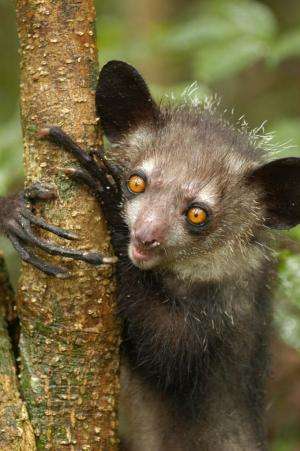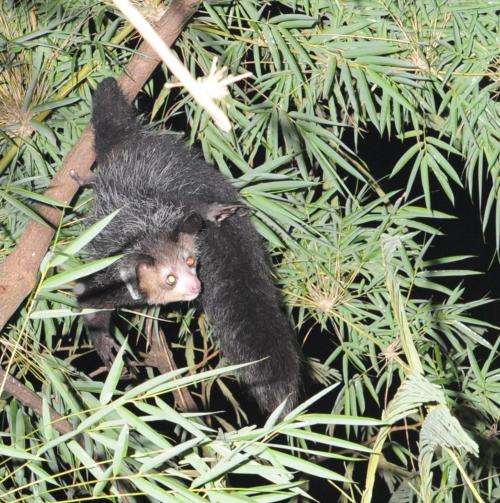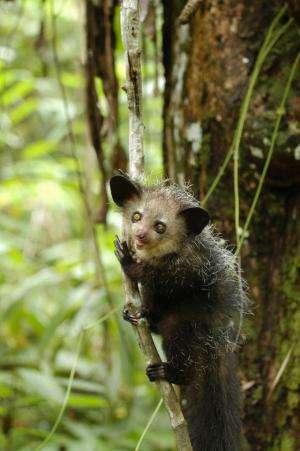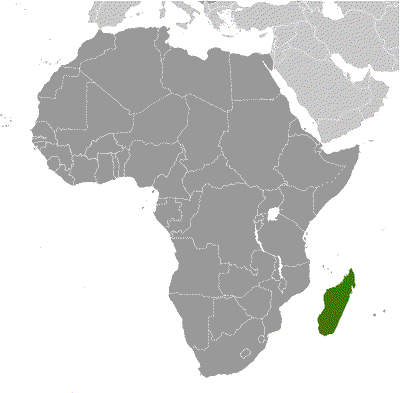Endangered lemurs' complete genomes sequenced, analyzed for conservation efforts

For the first time, the complete genomes of three separate populations of aye-ayes—a type of lemur—have been sequenced and analyzed in an effort to help guide conservation efforts. The results of the genome-sequence analyses will be published in an early edition of Proceedings of the National Academy of Sciences online during the week of 25 March 2013. The team of scientists is led by George H. Perry, an assistant professor of anthropology and biology at Penn State University; Webb Miller, a professor of biology and of computer science and engineering at Penn State; and Edward Louis, Director of Conservation Genetics at Omaha's Henry Doorly Zoo and Aquarium and Director of the Madagascar Biodiversity Partnership, NGO.
The aye-aye—a lemur that is found only on the island of Madagascar in the Indian Ocean—recently was re-classified as "Endangered" by the International Union for the Conservation of Nature. "The aye-aye is one of the world's most unusual and fascinating animals," said Perry. "Aye-ayes use continuously growing incisors to gnaw through the bark of dead trees and then a long, thin, and flexible middle finger to extract insect larvae, filling the ecological niche of a woodpecker. Aye-ayes are nocturnal, solitary, and have very low population densities, making them difficult to study and sample in the wild."
Perry added that he and other scientists are concerned about the long-term viability of aye-ayes as a species, given the loss and fragmentation of natural forest habitats in Madagascar. "Aye-aye population densities are very low, and individual aye-ayes have huge home-range requirements," said Perry. "As forest patches become smaller, there is a particular risk that there won't be sufficient numbers of individual aye-ayes in a given area to maintain a population over multiple generations. We were looking to make use of new genomic-sequencing technologies to characterize patterns of genetic diversity among some of the surviving aye-aye populations, with an eye towards the prioritization of conservation efforts."

Louis, with his team at Omaha's Henry Doorly Zoo and Aquarium and the Madagascar Biodiversity Partnership, worked to locate aye-ayes and collect DNA samples from three separate regions of Madagascar: the northern, eastern, and western regions. To discover the extent of the genetic diversity in present-day aye-ayes, the researchers generated the complete genome sequences of 12 individual aye-ayes. They then analyzed and compared the genomes of the three populations. They found that, while eastern and western aye-ayes are somewhat genetically distinct, aye-ayes in the northern part of the island and those in the east show a much more significant amount of genetic distance, suggesting an extensive period of time during which interbreeding has not occurred between the populations in these regions.
"Our next step was to compare aye-aye genetic diversity to present-day human genetic diversity," explained Miller. "This analysis can help us to gauge how long the aye-aye populations have been geographically separated and unable to interbreed." To make the comparison, the team gathered 12 complete human DNA sequences—the same number as the individual aye-aye sequences generated—from publicly available databases for three distinct human populations: African agriculturalists, individuals of European descent, and Southeast Asian individuals. Using Galaxy—an open-source, web-based computer platform designed at Penn State for data-intensive biomedical and genetic research—the team developed software to compare the two species' genetic distances. They found that present-day African and European human populations have a smaller amount of genetic distance than that found to exist between northern and eastern aye-aye populations, suggesting that the aye-aye populations were separated for an especially lengthy period of time by geographic barriers.

"We believe that northern aye-ayes have not been able to interbreed with other populations for some time. Although they are separated by a distance of only about 160 miles, high and extensive plateaus and major rivers may have made intermingling relatively infrequent," explained Miller. He added that the results of the team's data further suggest that the separation of the two aye-aye populations stretches back much longer than 2,300 years, which is when human settlers first arrived on the island and started burning the aye-ayes' forest habitat and hunting lemurs.
The team members hope that their findings will help to guide future conservation efforts for the species. "This work highlights an important region of aye-aye biodiversity in northern Madagascar, and this unique biodiversity is not preserved anywhere except in the wild," said Louis. "There is tremendous historical loss of habitat in northern Madagascar that is continuing at an unsustainable rate today. This study is an excellent example of how a comprehensive and coordinated effort in the field and laboratory can identify previously unknown patterns of biodiversity for an endangered species, which then can be used by conservation organizations to base their management strategies."

The authors added that, in future research, they would like to sequence the genomes of other lemur species—over 70 percent of which are considered endangered or critically endangered—as well as aye-ayes from the southern reaches of the island of Madagascar.
Journal information: Proceedings of the National Academy of Sciences
Provided by Pennsylvania State University



















